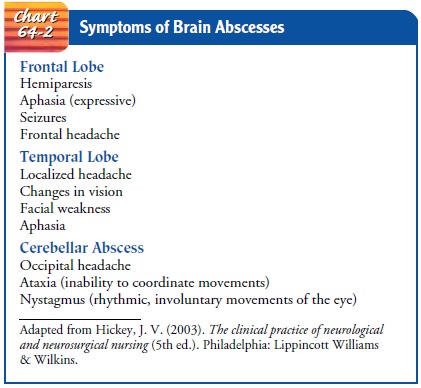Chapter: Medical Surgical Nursing: Management of Patients With Neurologic Infections, Autoimmune Disorders, and Neuropathies
Brain Abscess - Infectious Neurologic Disorders
BRAIN ABSCESS
Although brain abscess is relatively rare, it is a
complication en-countered increasingly in patients whose immune systems have
been suppressed either through therapy or disease.
Pathophysiology
A brain abscess is a collection of infectious material
within the tissue of the brain. It may occur by direct invasion of the brain
from intracranial trauma or surgery; by spread of infection from nearby sites,
such as the sinuses, ears, and teeth (paranasal sinus infections, otitis media,
dental sepsis); or by spread of infection from other organs (lung abscess,
infective endocarditis) (Hickey, 2003). To prevent brain abscess, otitis media,
mastoiditis, sinusi-tis, dental infections, and systemic infections should be
treated promptly.
Clinical Manifestations
The clinical manifestations
of a brain abscess result from alter-ations in intracranial dynamics (edema,
brain shift), infection, or the location of the abscess (Chart 64-2). Headache,
usually worse in the morning, is the most prevailing symptom. Vomiting is also
common. Focal neurologic signs (weakness of an extremity, de-creasing vision,
seizures) may occur, depending on the site of the abscess. There may be a
change in mental status, as reflected in lethargic, confused, irritable, or
disoriented behavior. Fever may or may not be present.

Assessment and Diagnostic Findings
Repeated neurologic examinations and continuing assessment of the patient are necessary to determine the location of the abscess. A computed tomography (CT) scan is invaluable in locating the site of the abscess, after the evolution and resolution of suppura-tive lesions, and in determining the optimal time for surgical inter vention. A magnetic resonance imaging (MRI) scan is useful to obtain images of the brain stem and posterior fossa if an abscess is suspected in these areas.
Medical Management
Brain abscess is treated
with antimicrobial therapy and surgical incision or aspiration. If the abscess
is encapsulated, CT-guided stereotactic needle aspiration under local anesthesia
may be per-formed. Antimicrobial treatment is prescribed to eliminate the
causative organism or reduce its virulence.
Penicillin G (20 million
U) and chloramphenicol (Chloro-mycetin) (4 to 6 g/day given intravenously in
divided doses) are usually prescribed because anaerobic streptococci and Bacterioides are the most common
causative organisms (Hickey, 2003). Large IV doses are usually prescribed
preoperatively to penetrate the blood–brain barrier and reach the abscess. The
therapy is con-tinued postoperatively. Corticosteroids may be prescribed to
help reduce the inflammatory cerebral edema if the patient shows evidence of an
increasing neurologic deficit. Antiseizure medica-tions (phenytoin,
phenobarbital) may be prescribed to prevent seizures. Multiple abscesses may be
treated with appropriate anti-microbial therapy alone, with close monitoring by
CT scans.
Nursing Management
Nursing care focuses on
ongoing assessment of the neurologic sta-tus, administering medications,
assessing the response to treat-ment, and providing supportive care.
Ongoing neurologic
assessment alerts the nurse to changes in ICP, which may indicate a need for
more aggressive intervention. The nurse also assesses and documents the
responses to medica-tions. Blood laboratory test results, specifically blood
glucose and serum potassium levels, need to be closely monitored when
cor-ticosteroids are prescribed. Medical intervention may be required to return
these values to normal or acceptable levels.
Patient safety is also a key nursing responsibility.
Injury may result from decreased level of consciousness and falls related to
motor weakness or seizures.
The patient with a brain abscess is extremely ill, and
neuro-logic deficits may remain after treatment, such as hemiparesis, seizures,
visual deficits, and cranial nerve palsies. Focal seizures are the most common
sequelae, occurring in about 30% of pa-tients (Hickey, 2003). The nurse must
assess the family’s ability to express their distress at the patient’s
condition, cope with the patient’s illness and deficits, and obtain support.
Related Topics